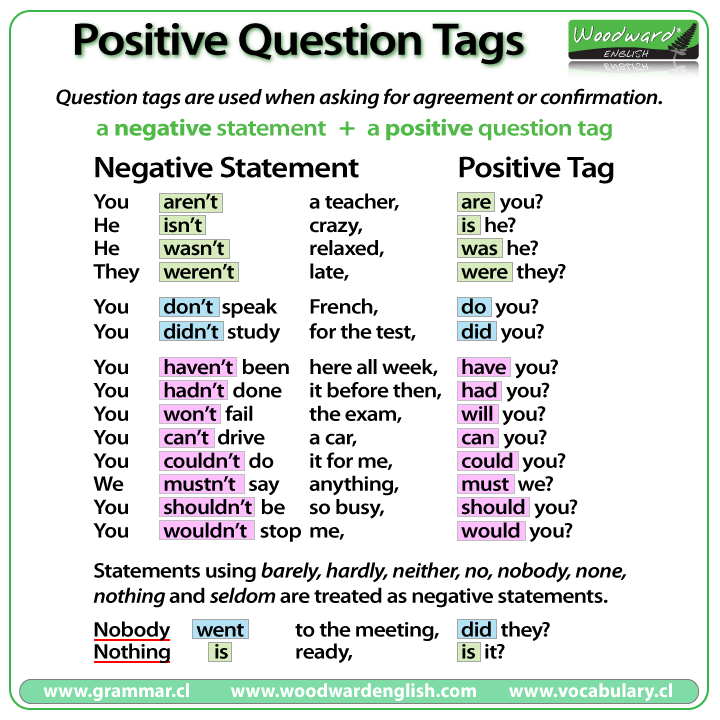Master English Question Tags Boost Your Communication Skills
Have you ever wondered how to smoothly confirm information or engage someone in a conversation in English? Question tags are the key! These small additions to the end of a sentence can dramatically impact how you communicate. They can transform a statement into a question, inviting confirmation, seeking agreement, or even expressing surprise. Mastering question tags is essential for anyone looking to enhance their English fluency and conversational skills.
Question tags, also known as tag questions, are short questions added to the end of declarative sentences. They're a fundamental aspect of spoken English, allowing for more dynamic and engaging conversations. From confirming details to softening commands, these little grammatical tools play a significant role in everyday communication. Understanding their nuances is crucial for achieving true fluency.
The precise origin of question tags is difficult to pinpoint, but they've likely evolved organically within the English language over centuries. Their usage reflects a natural human tendency to seek confirmation and engage in dialogue. While their structure might seem simple at first glance, question tags involve a subtle interplay of grammar and intonation, adding layers of meaning beyond the words themselves.
Question tags are important for several reasons. They help avoid misunderstandings by allowing speakers to check if their assumptions are correct. They also promote interaction, encouraging the listener to respond and participate in the conversation. Moreover, question tags can soften the tone of a statement, making it sound less assertive and more polite, especially useful in cross-cultural communication.
One common challenge with question tags is mastering the correct combination of auxiliary verb and pronoun. Another difficulty lies in matching the intonation of the question tag with the intended meaning. A rising intonation indicates genuine uncertainty, while a falling intonation implies confirmation or expectation of agreement. These nuances can be tricky for non-native speakers to grasp.
A question tag typically consists of an auxiliary verb (e.g., is, are, do, does, have, has, can, will) and a subject pronoun (e.g., I, you, he, she, it, we, they). The auxiliary verb in the tag usually corresponds to the auxiliary verb in the main clause, and the pronoun matches the subject of the main clause. For instance, "You speak English, don't you?" or "She is coming, isn't she?".
Advantages of using question tags:
1. Confirmation: "He finished the project, didn't he?" (Seeking confirmation of completion)
2. Engagement: "It's a beautiful day, isn't it?" (Initiating conversation)
3. Politeness: "You could open the window, couldn't you?" (Softening a request)
Step-by-step guide:
1. Identify the auxiliary verb in the main clause.
2. Use the same auxiliary verb in the question tag.
3. If the main clause is positive, the tag is negative, and vice versa.
4. Use the correct subject pronoun in the tag.Advantages and Disadvantages of Question Tags
| Advantages | Disadvantages |
|---|---|
| Enhanced communication and clarity | Potential for overuse leading to informal or repetitive speech |
| Politeness and engagement in conversations | Difficulty for non-native speakers to master intonation and structure |
Five best practices:
1. Match the auxiliary verb: Ensure the tag uses the same auxiliary as the main clause.
2. Observe polarity: Use a negative tag with a positive statement and vice versa.
3. Pronoun agreement: The pronoun in the tag should match the subject of the main clause.
4. Intonation matters: Use rising intonation for genuine questions and falling intonation for confirmation.
5. Context awareness: Consider the context to avoid unintended meanings or awkwardness.
Five examples:
1. You like coffee, don't you?
2. They aren't coming, are they?
3. He has finished, hasn't he?
4. She can drive, can't she?
5. We should go, shouldn't we?
FAQ:
1. What is a question tag? A: A short question added to the end of a statement.
2. How do I form a question tag? A: Use the auxiliary verb from the statement and a matching pronoun.
3. When do I use a positive tag? A: After a negative statement.
4. When do I use a negative tag? A: After a positive statement.
5. What is the purpose of a question tag? A: To confirm information, engage in conversation, or soften a statement.
6. How does intonation affect the meaning of a question tag? A: Rising intonation indicates a genuine question, falling intonation indicates confirmation.
7. Are question tags formal or informal? A: Generally informal, but can be used in some formal contexts.
8. Can question tags be used in writing? A: Less common, but can be used in informal writing like emails or dialogue.
Tips and tricks: Pay attention to the intonation and context to convey the right meaning. Practice using question tags in different situations to improve your fluency.
In conclusion, mastering question tags is a valuable asset for anyone seeking to improve their English communication skills. They allow for clearer communication, smoother conversations, and more engaging interactions. While there are some challenges in mastering their nuances, the benefits far outweigh the effort. By understanding the rules and practicing regularly, you can confidently incorporate question tags into your everyday English, making your conversations more dynamic and expressive. So, go ahead, start using question tags and see the difference they make in your communication. You won't regret it, will you?
Verenigd in jezus naam kracht en eenheid vinden
Organiseer je content met een printbare contentkalender template
Regen in rain am lech wetter ontdekken














